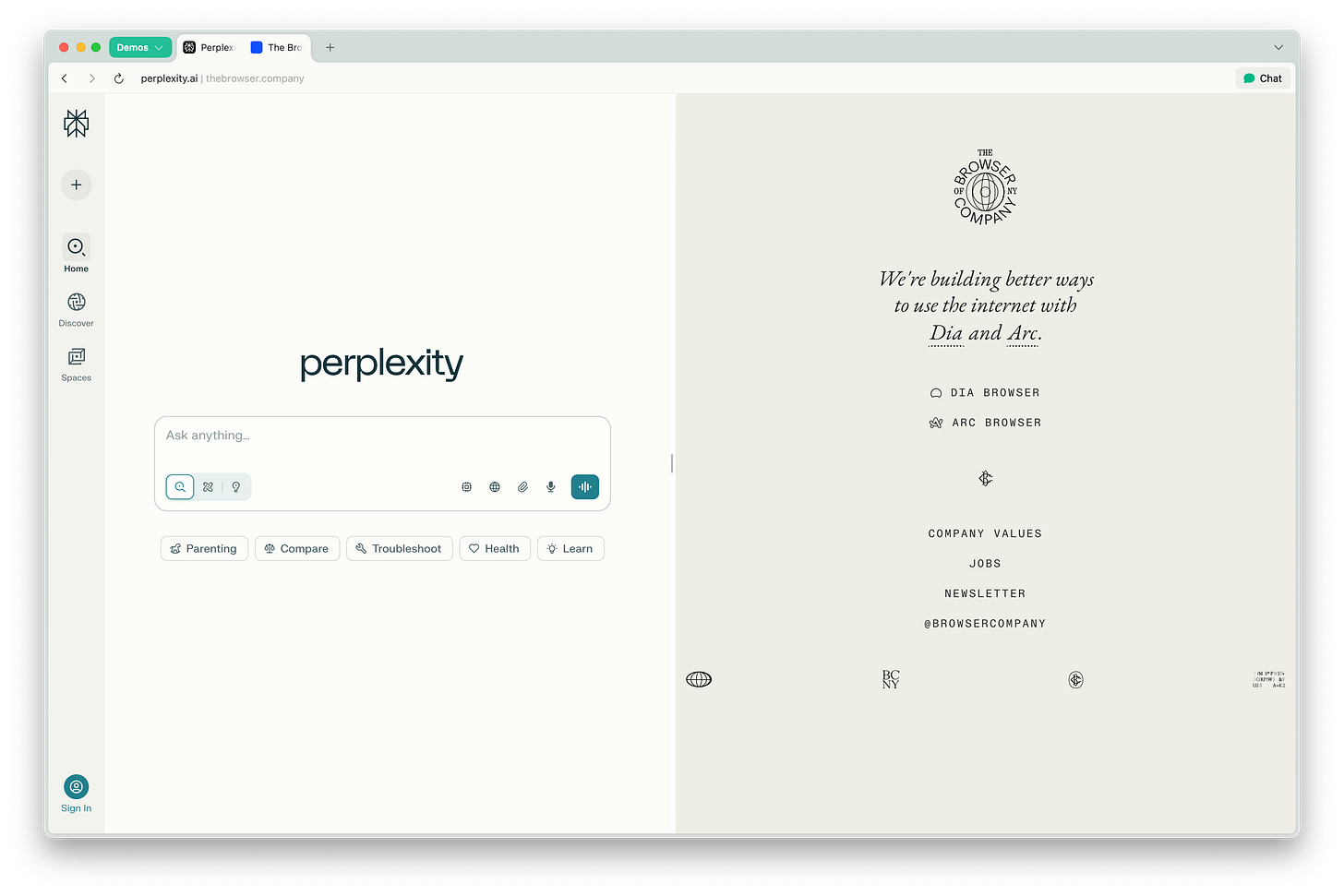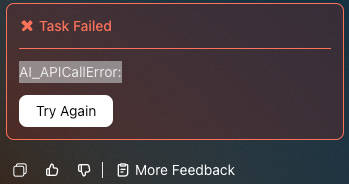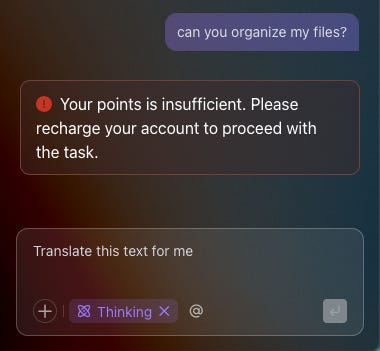Browsing, Rewired: My Dive into the AI Browser Frontier
First it was Dia, then came Comet. I downloaded Fellou.ai the other day, which bills itself as the first “agentic browser.” As I type this I’m also installing Genspark’s new AI browser. (Apparently I collect browsers now. Don’t judge.)
So…what is an “AI browser,” really?
There are two answers. The purist one: a browser with native reasoning and page context. The practical one: a regular browser with AI that can read your tabs, act across pages, and save you from copy-paste gymnastics.
Think about how we used to work online: the internet gave us speed, but also noise. You could search and find plenty of information, but actually rationalizing it was still a manual process. Most of us ended up doing the dance, search, skim, then paste snippets into ChatGPT or Claude.
As LLMs improved and multimodal arrived, that dance got shorter. Paste a screenshot, let the model read it. Within about 18 months of ChatGPT’s launch, multimodal became table stakes, and it already feels quaint that these systems once only handled text.
AI browsers take it a step further: they remove the shuttling. One tool, one context. Not just summarize this but compare those, book that, fill this out, all inside the browser. That’s the new frontier: agentic behavior.
First it was text, then images, then audio, and now video is the next frontier (though models like ChatGPT still can’t natively “watch” a video, only parse frames). But since this isn’t an article on multimodal AI, let’s get back to those AI browsers I was just talking about.
Who are the Players in the Game?
This isn’t exhaustive (with the current pace, two more browsers will probably launch next week), but here’s the current field:
Dia (The Browser Company): “Chat with your tabs,” skills, and (with permission) memory based on your real browsing. Now the company’s main focus, and plot twist, Atlassian is acquiring them to push Dia into enterprise workflows.
Perplexity Comet: The most “agentic” right now. Compare products, click/type/submit across sites, search your history, even manage email/calendar. Chromium-based, started invite-only, now expanding.
Microsoft Edge (Copilot Mode): Lets Copilot see your tabs to summarize/compare. Free, opt-in, with clear indicators. Marching toward booking and other actions.
Chrome (Gemini in Chrome): Page-aware summaries baked into Chrome. Helpful, but feels more like a feature than a full product, no multi-tab awareness or task execution yet.
Safari (Apple Intelligence): Adds Summarize/Highlights in Reader mode (iOS 18/macOS Sequoia). Privacy-forward, mostly on-device. Early steps, not yet at Dia/Comet levels.
Brave (Leo): Privacy-first with multi-tab context. In practice, results were inconsistent, it can summarize, but struggles with real actions like managing emails.
Opera (Aria): Free, integrated across Opera/Opera GX/Opera Mini. Useful for quick answers, but limited in action-taking and clunky UI.
Kagi + Orion: Paid, privacy-first search paired with a zero-telemetry browser. Niche, beloved by its community, worth watching as a control group for “AI without ads.”
SigmaOS / Sigma Browser: Productivity-focused with workspaces and early “agentic” ideas (A1Kit). Promising, but right now feels closer to smart summarization than full AI action.
Firefox (iOS): “Shake to Summarize” feature. Clever, but limited rollout and not competitive with the bigger players.
Which AI Browsers Work?
Full disclosure: the rest of this article focuses on Dia, Comet, and Fellou, mainly because I’ve been living in Dia and Comet for the past month, and just spent some time testing Fellou. But here’s my snapshot take on the whole field:
Dia – A great browser. Smooth, intuitive, fun to use. My only gripe: no tab groups.
Comet – My new default. Tab groups + productivity features are game changers.
Microsoft Edge (Copilot Mode) – Haven’t tested deeply. Honestly, earlier Copilot attempts left me so underwhelmed I didn’t have the energy.
Chrome (Gemini in Chrome) – Solid for summaries, but limited. No multi-tab awareness, no task execution. Feels like an add-on, not a full product.
Safari (Apple Intelligence) – Interesting touches (like distraction mode), but nowhere near Dia/Comet yet. More “AI features” than “AI browser.”
Brave (Leo) – Disappointing. Struggled to accurately parse emails across folders. Feels experimental, not ready for real workflow use.
Opera (Aria) – Same issues as Brave. Limited action-taking, clunky overlay UI. Not compelling.
Kagi + Orion – Haven’t tested, but love their “zero-telemetry, no ads” approach. Worth watching.
SigmaOS / Sigma Browser – Great ideas (workspaces, productivity flow), but the AI feels stuck at “summarize this page.” Needs more.
Firefox (iOS) – Cute “Shake to Summarize” trick. Not enough to matter.
My hands-on: Dia vs. Comet (and why I switched)
Local Models (Quick Aside)
Genspark’s new AI browser is interesting because it lets you download and run models locally. That could mean faster responses and no per-use costs. But in a browser context, the tradeoff is real: local models hit performance ceilings compared to hosted LLMs. Worth watching, but not a game changer yet.
Real-World Use Cases
AI browsers shine when one tab needs info from another. Instead of bouncing back and forth (or copy-pasting), you can just ask: “@PizzaPlace what’s the total for this order?” The example may be pizza, but the real win is research, referencing data across tabs without breaking your flow.
This sounds small, but it matters. It saves consolidation cycles…though I’ll admit, there’s a habit retraining curve. Sometimes I have to remind myself to use the agent instead of falling back on old workflows.
Beyond Tabs
It’s not just cross-tab queries. Think of anything you’ve asked an LLM to do, draft emails, summarize PDFs, explain images. An AI browser brings those right into your workflow:
Summarize or extract from attached files (PDFs, XML, etc.)
Search your own browsing history with LLM context
Write, code, research, and edit in-place
One killer feature: context-aware help inside complex platforms. Example: I forgot how to set a monthly budget in GCP. Instead of Googling it, I asked the assistant right there in the GCP console, and it gave me the exact steps without leaving the page.
Why I Switched
Here’s my hot take: Comet and Dia are remarkably similar. But for me, one feature tipped the scales: tab groups. Dia doesn’t have them; Comet does. That’s it.
That said, Dia does have a clever split-tab view, multiple tabs inside one tab, which I still love for certain workflows:
Comet in Action
As mentioned Perplexity’s browser is named Comet and it centers on research, synthesis, and agentic automation. It integrates Perplexity’s AI for powerful search, summary, and multi-tab reasoning, and can perform agentic tasks such as organizing tabs, summarizing pages, and acting across the web on behalf of the user. It is especially strong for users focusing on research-heavy workflows and automation. I’ve already mentioned that I like tab groups, but what if I could have my AI assistant “organize tabs” for me.
I opened 15 tabs in the Comet browser, (and to provide some proof that users do need to retrain themselves I started to type the list of tabs here, and then realized I didn’t need to, because Comet can do it for me).
Okay great, so I have a bunch of messy tabs - what can Comet do? Let’s see it in action.
As you can see it responds and tells me that my open tabs have been organized according to this:
NFL & Sports: NFL.com, Washington Commanders, ESPN
News: Fox News, CNN, NewsNation
AI & Tech: Dia Browser, Fellou, Perplexity, Anthropic, OpenAI, xAI
Social: X.com
Courses & Learning: Coursera, Sophia Learning
This may seem trivial, but sometimes it’s the simple things that matter most. Comet can take action and actually do things for you. To highlight this capability I asked my Comet assistant to find a few recipes, and then had it populate my shopping cart with the necessary ingredients. Once again, maybe online grocery shopping isn’t your thing, but imagine the power of this capability for something that is.
This is one of the main difference between Dia and Comet, as you’ll see later Dia can summarize and compare beautifully, but Comet can do work on the page itself.
Comet Shortcuts & Tasks
• Shortcuts: Pre-built mini-prompts for repetitive tasks (e.g., “Evaluate this deal” on a product page). I don’t use them much, but they’re handy.
• Tasks: Scheduled custom alerts, reminders, and reports. Create a query, set a schedule, get updates by email or push.
Dia’s Strength
Dia’s superpower is deep tab context. Writing help, document review, contextual suggestions, all solid. Dia’s own site has a great layout of what it does well, which you can see here.
For the sake of comparisons though I asked it to do the same recipe to shopping test: it gave me the recipe and ingredients list perfectly, but couldn’t update the cart.
To be fair, it excelled at item comparisons and value assessments, Dia is still a strong research companion.
Dia vs. Comet
I still use both, but if forced to choose? Comet. Its ability to take action, actually do things for you, plus tab groups and auto-organization make it the more practical daily driver. Dia remains excellent for contextual reasoning, but Comet wins on execution.
I don’t normally do this but…
Fellou.ai is a rip off.
Fellou.ai is a rip off.
Fellou is a new player billing itself as “the world’s first agentic browser.” Familiar claim, but it does feel a little different. Its pitch: spin up “shadow workspaces” (which coincidentally sounds like the place a supervillain devises their evil plans from) that run tasks in parallel, schedule a daily portfolio analysis, job hunt from your resume, summarize notes into a mini-website, even prioritize your inbox. Sounds powerful.
The problem? Cost.
I test a lot of AI tools, so I’m used to subscriptions. Fellou’s Plus plan is $19.90/month for 2,000 credits (you start with 5,000 signup credits). I figured I’d try one of their own showcase examples. The estimate was 400–1,400 credits. I ran it…
It choked on a captcha.
I solved it manually.
Then it failed with the oh-so-helpful error: AI_APICallError.
I tried again. Same story. So I pivoted, asked it to organize some files (a local task). And that is when I realized that my failed example depleted my points/credits.
Bottom line: I paid $20 for 2,000 points and basically got one broken demo run.
Reality Check
If you don’t complete the task, you don’t get to take my points
If one task cost $20, then I don’t care how generous my expense account is, I’m not using it.
Grammar matters: it’s “Your points are insufficient.”
Don’t charge points for things like “follow us on X.”
Consistency matters, why 2 credits once, then 941 the next?
If 10 X posts based on my articles costs $20+, I’m in the wrong business.
Access (and a little giveaway)
Remember when Gmail first rolled out with invite codes? That’s what AI browsers feel like right now. Both Dia and Comet are still invite-only, and I have a handful of codes.
Here’s the deal:
The first 10 new Substack subscribers who drop a comment below will get an invite code from me.
Fellou is technically public, but has a referral system. If you’re curious (and don’t mind burning credits), I’ll send you a Fellou invite as well.
💡 Why I’m doing this: I want to build a community around testing these tools in the real world, not just reading about them. Subscribing makes sure you don’t miss future breakdowns, and commenting helps me know who actually wants hands-on access.
So if you want in, subscribe → comment → claim your spot.
Viability matters.
Cool features aside, only some of these models are sustainable. Opera still makes money the old-fashioned way (search + ads). Perplexity is betting on subscriptions and enterprise. Indie players like Brave are fighting uphill without those default-search rents. Who pays decides who survives.
Conclusion
AI browsers are here. They’re powerful, useful, and if you aren’t already using one, you will be soon. The “AI browser” won’t replace Chrome, Edge, or Safari, those browsers will simply become AI browsers. Google’s already shipping Gemini in Chrome; Microsoft has Copilot Mode; Apple is weaving Apple Intelligence into Safari. Within a year, every major browser will have native AI that can reason over your current page, your tabs, and (with permission) your history. If a browser doesn’t, it won’t be “major” for long.
And that’s why I like writing these pieces: not just to track what’s shipping, but to test them, break them, and show you what actually matters. If you want to stop just reading about AI browsers and actually try one, head to the Access section above, subscribe, drop a comment, and I’ll send invite codes to the first 10 people.







The thing with new AI browsers - I'm edgy about exposing all my data to a brand new startup. New VC funded, hyper growth focused, little to lose startup? I'm not so sure.
Chrome has built trust over the years, part of a multi-trillion dollar org with plenty to lose. Plus they already have all my data for the past 15 years.
As of today, Chrome is also an "AI Browser"
https://blog.google/products/chrome/new-ai-features-for-chrome/